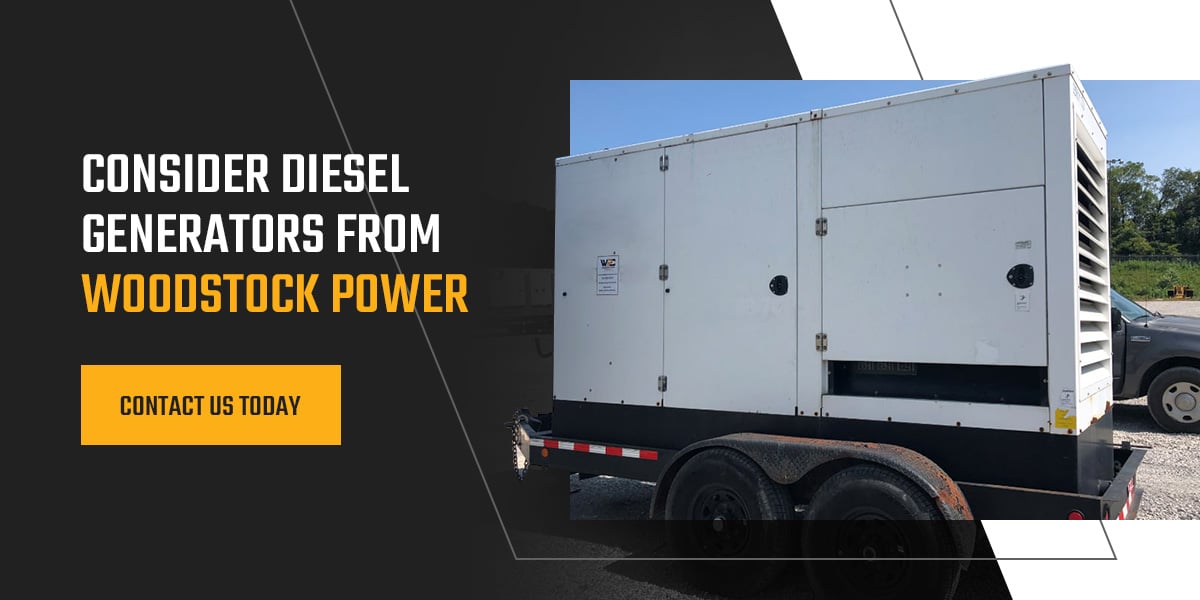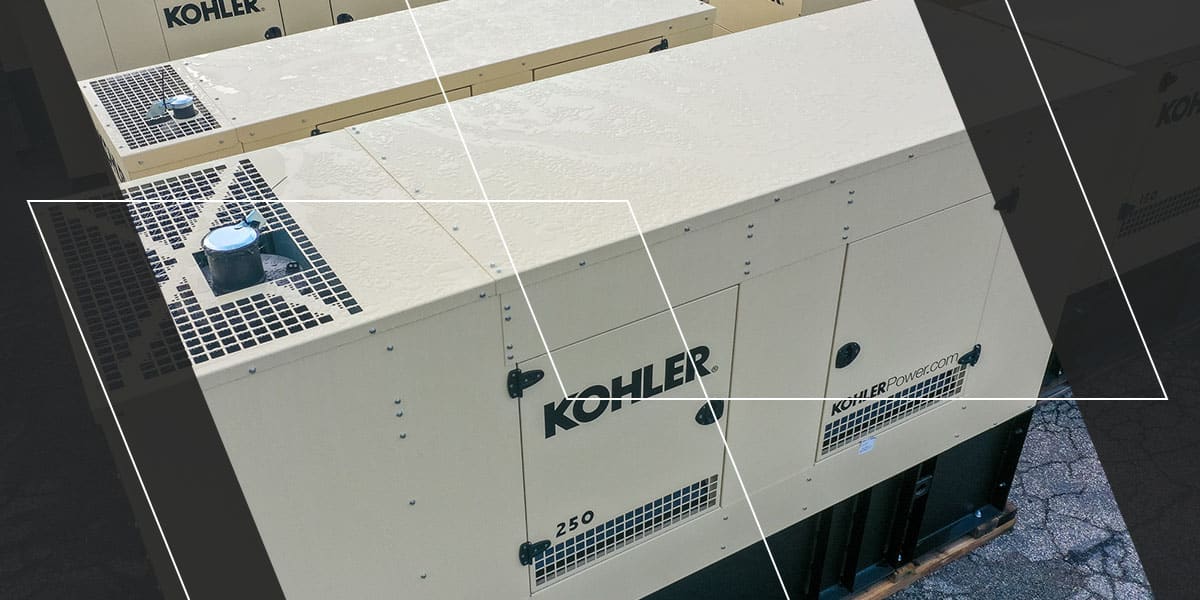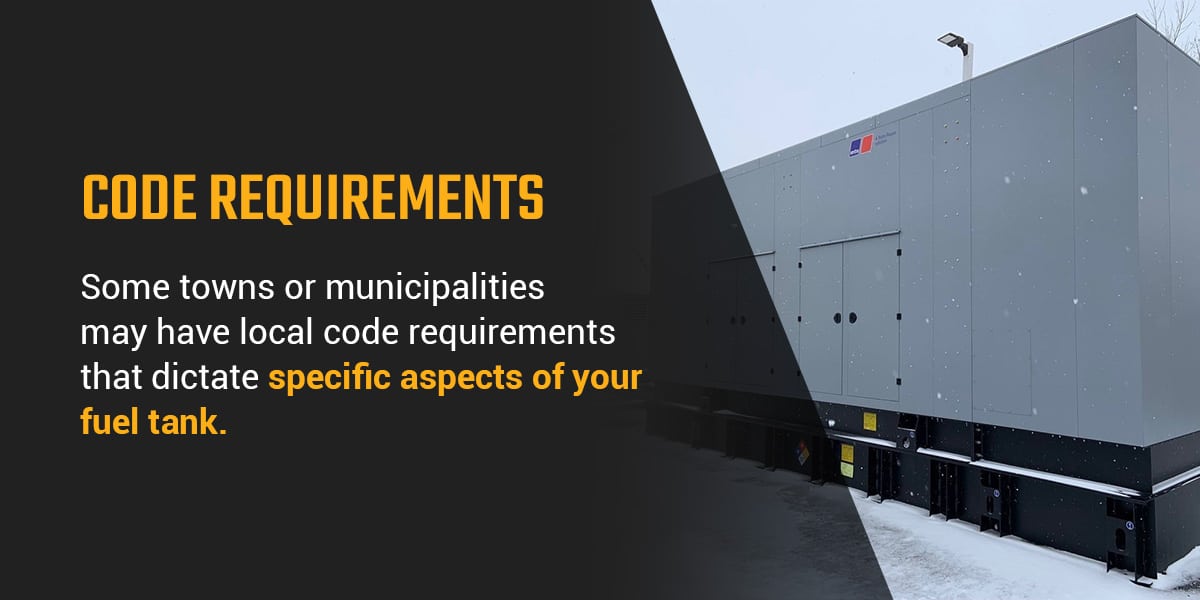Choosing the Right Diesel Generator Fuel Tank for Your Facility
Diesel generators are common choices for backup power solutions. Since these generators run on diesel fuel, you need a fuel tank to store fuel to have on standby. When your facility or business loses power, the generator can use the diesel in the tank to operate and begin generating power. Generator fuel tanks are not one-size-fits-all — you’ll need to find a fuel tank that meets your facility’s and generator’s specific needs.
Learn more about how to find the best diesel fuel tank for your generator.
How to Choose the Right Diesel Generator Fuel Tank
Diesel generator fuel tanks are available in various types and specifications and can often be customized to meet certain needs. How do you know what to look for? Here are a few aspects to consider when choosing the right tank.
Type of Tank
One of the first considerations when choosing a generator diesel tank is what type of tank would meet your needs. Make sure to determine your available space and budget when choosing a tank type. Here are three of the most common types of generator fuel tanks:
- Above-ground storage tanks: Above-ground fuel tanks sit above the ground, which means they’re visible. Typically, these tanks are installed at a distance from the facility because they pose fire and spill hazards. Because these tanks are exposed, it’s best to use protective structures like sheds to shield the tank from the weather.
- Sub-base tanks: These tanks are generally used to store up to 1,000 gallons of fuel. Generally, the generator is mounted on top of a sub-base tank, so the tank sits above ground and under the generator’s base. Many sub-base tanks are double-walled to help prevent leaks and can be customized to specific capacities. Since they sit above ground, you may want to put these types of tanks in an enclosure to help protect them from the elements.
- Underground storage tanks: Underground storage tanks are installed in a concrete cavity in the ground. Because these tanks are shielded from the outside environment, they typically have a longer life span. While underground fuel tank installation can be costly, they’re beneficial because any leaks or spills are contained to a smaller area, which helps eliminate risk.
Fuel Tank Run-Time
The fuel tank run-time is the length of time your generator could run at full capacity before the fuel tank is empty. The tank run-time will vary depending on the tank size, which is why it’s important to consider size when looking for the right tank. Remember that most generators won’t normally run at full capacity so the fuel should last longer than the estimated run-time, although it helps you prepare for the worst-case scenario.
Tank Height
Generator fuel tanks can vary significantly in height, which affects how easily you can view the control panel. For example, the control panel on a shorter tank may be at or below eye level, while the panel on a taller tank may sit above eye level. Taller tanks may require a ladder or permanent platform for easier access, operation and maintenance.
Code Requirements
Some towns or municipalities may have local code requirements that dictate specific aspects of your fuel tank. For example, many towns require you to have a tank with a specific minimum tank level. Other potential code requirements may include fuel-spill containment, extended venting, high fuel level shut-off valves or scheduled pressure testing. It’s important to understand any local code requirements in your area to ensure you’re choosing an appropriate generator tank.
The International Organization for Standardization (ISO) also has standards regarding the application, ratings and performance of diesel generators. ISO 8528 defines standard regulations for temperature, sound and vibration, as well as standard ratings for annual run-time expectation, load factor, load variability and more. ISO requirements can help you find a generator that effectively suits your needs as well as help you determine how to safely implement the generator at your facility.
Fuel Type
There are two grades of standard diesel fuel: #1 and #2. The fuel grade you use in your generator tank will mostly depend on the climate you’re located in. Diesel fuel will begin gelling in a standby tank after some time, especially in colder climates. Grade #1 diesel is ideal for colder climates because it’s more resistant to gelling. Grade #2 diesel has a higher energy output and is preferred where gelling is less of a concern. In many cases, you’ll find a blend of the two depending on local weather conditions.
Red dye diesel is also commonly used in generators. Red dye diesel is similar to standard diesel — the main difference being the color. Red dye diesel is illegal to use in vehicles driven on government roads because there’s no fuel tax on this type of diesel. It can only be legally used in non-road engines — using red dye diesel in a road vehicle will result in a fine. Since it cannot be used on roads, red dye diesel can be a cost-effective option for fueling generators.
How Do You Size a Fuel Tank for a Generator?
Special consideration should be made regarding the fuel tank size necessary for your generator. Because fuel expands, your tank cannot be filled up completely to prevent the high risk of overflow and spillage. Depending on the tank’s shape, only about 80% of a tank’s capacity can be used, and it should not be completely emptied during operation. Because of these limitations, appropriate sizing is critical to ensuring you have enough fuel to run the generator.
To calculate the necessary fuel capacity, you’ll need to know the generator’s fuel consumption rate and the desired run-time. Multiplying these two numbers will give you the required gallon capacity needed to use the generator. For example, let’s say your generator consumes 400 liters of diesel per hour and you need it to have a run-time of at least 48 hours. Multiply 400 liters per hour by 48 hours and you can determine that you’d need at least 19,200 liters of fuel.
To ensure you can store over 19,000 liters of diesel fuel in your tank and account for the unusable capacity, you’ll want to size up. In this case, you’d likely want to look at tanks with a capacity over 20,000 liters.
Most importantly, it is important to reference the specification sheet for your specific generator in order to know the exact fuel consumption rate for your generator.
How to Safely Install Your Diesel Fuel Tank
Because fuel is combustible, there are laws at the federal, state and city levels to regulate fuel storage. For example, your state may require your tank to be at least 20 feet from your generator while your city requires it to be at least 30 feet away. These types of regulations must be considered when installing your tank, especially because most tanks are connected to the generator. In that case, you’d need to plan for piping to be laid between the tank and the generator.
Consider Diesel Generators from Woodstock Power
At Woodstock Power, you’ll find a sizable inventory of refurbished name brand diesel generators. You want to be able to rely on your backup power source, which is why we put our generators to the test before selling them. We’ll help you every step of the way, from finding a quality generator and sizing your fuel tank to meeting code requirements and installing the setup.
For more information on diesel fuel tanks, assistance with sizing your tank or to replace or upgrade your tank, reach out to us online today.



